Pengyu Wang
MS-BART: Unified Modeling of Mass Spectra and Molecules for Structure Elucidation
Oct 23, 2025Abstract:Mass spectrometry (MS) plays a critical role in molecular identification, significantly advancing scientific discovery. However, structure elucidation from MS data remains challenging due to the scarcity of annotated spectra. While large-scale pretraining has proven effective in addressing data scarcity in other domains, applying this paradigm to mass spectrometry is hindered by the complexity and heterogeneity of raw spectral signals. To address this, we propose MS-BART, a unified modeling framework that maps mass spectra and molecular structures into a shared token vocabulary, enabling cross-modal learning through large-scale pretraining on reliably computed fingerprint-molecule datasets. Multi-task pretraining objectives further enhance MS-BART's generalization by jointly optimizing denoising and translation task. The pretrained model is subsequently transferred to experimental spectra through finetuning on fingerprint predictions generated with MIST, a pre-trained spectral inference model, thereby enhancing robustness to real-world spectral variability. While finetuning alleviates the distributional difference, MS-BART still suffers molecular hallucination and requires further alignment. We therefore introduce a chemical feedback mechanism that guides the model toward generating molecules closer to the reference structure. Extensive evaluations demonstrate that MS-BART achieves SOTA performance across 5/12 key metrics on MassSpecGym and NPLIB1 and is faster by one order of magnitude than competing diffusion-based methods, while comprehensive ablation studies systematically validate the model's effectiveness and robustness.
Rec-RIR: Monaural Blind Room Impulse Response Identification via DNN-based Reverberant Speech Reconstruction in STFT Domain
Sep 19, 2025
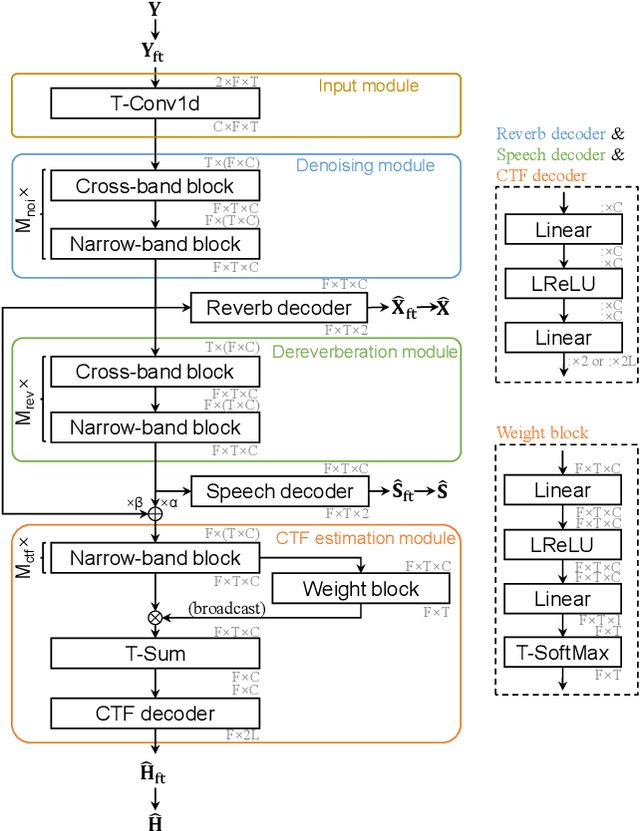
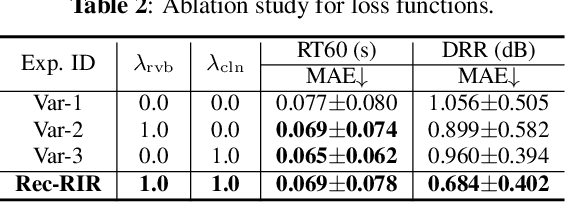
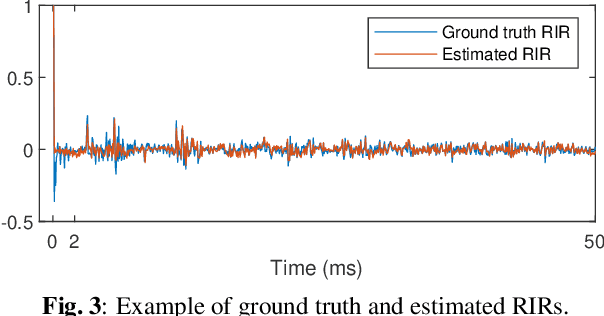
Abstract:Room impulse response (RIR) characterizes the complete propagation process of sound in an enclosed space. This paper presents Rec-RIR for monaural blind RIR identification. Rec-RIR is developed based on the convolutive transfer function (CTF) approximation, which models reverberation effect within narrow-band filter banks in the short-time Fourier transform (STFT) domain. Specifically, we propose a deep neural network (DNN) with cross-band and narrow-band blocks to estimate the CTF filter. The DNN is trained through reconstructing the noise-free reverberant speech spectra. This objective enables stable and straightforward supervised training. Subsequently, a pseudo intrusive measurement process is employed to convert the CTF filter estimate into time-domain RIR by simulating a common intrusive RIR measurement procedure. Experimental results demonstrate that Rec-RIR achieves state-of-the-art (SOTA) performance in both RIR identification and acoustic parameter estimation. Open-source codes are available online at https://github.com/Audio-WestlakeU/Rec-RIR.
UnifiedVisual: A Framework for Constructing Unified Vision-Language Datasets
Sep 18, 2025Abstract:Unified vision large language models (VLLMs) have recently achieved impressive advancements in both multimodal understanding and generation, powering applications such as visual question answering and text-guided image synthesis. However, progress in unified VLLMs remains constrained by the lack of datasets that fully exploit the synergistic potential between these two core abilities. Existing datasets typically address understanding and generation in isolation, thereby limiting the performance of unified VLLMs. To bridge this critical gap, we introduce a novel dataset construction framework, UnifiedVisual, and present UnifiedVisual-240K, a high-quality dataset meticulously designed to facilitate mutual enhancement between multimodal understanding and generation. UnifiedVisual-240K seamlessly integrates diverse visual and textual inputs and outputs, enabling comprehensive cross-modal reasoning and precise text-to-image alignment. Our dataset encompasses a wide spectrum of tasks and data sources, ensuring rich diversity and addressing key shortcomings of prior resources. Extensive experiments demonstrate that models trained on UnifiedVisual-240K consistently achieve strong performance across a wide range of tasks. Notably, these models exhibit significant mutual reinforcement between multimodal understanding and generation, further validating the effectiveness of our framework and dataset. We believe UnifiedVisual represents a new growth point for advancing unified VLLMs and unlocking their full potential. Our code and datasets is available at https://github.com/fnlp-vision/UnifiedVisual.
Decoupled Proxy Alignment: Mitigating Language Prior Conflict for Multimodal Alignment in MLLM
Sep 18, 2025Abstract:Multimodal large language models (MLLMs) have gained significant attention due to their impressive ability to integrate vision and language modalities. Recent advancements in MLLMs have primarily focused on improving performance through high-quality datasets, novel architectures, and optimized training strategies. However, in this paper, we identify a previously overlooked issue, language prior conflict, a mismatch between the inherent language priors of large language models (LLMs) and the language priors in training datasets. This conflict leads to suboptimal vision-language alignment, as MLLMs are prone to adapting to the language style of training samples. To address this issue, we propose a novel training method called Decoupled Proxy Alignment (DPA). DPA introduces two key innovations: (1) the use of a proxy LLM during pretraining to decouple the vision-language alignment process from language prior interference, and (2) dynamic loss adjustment based on visual relevance to strengthen optimization signals for visually relevant tokens. Extensive experiments demonstrate that DPA significantly mitigates the language prior conflict, achieving superior alignment performance across diverse datasets, model families, and scales. Our method not only improves the effectiveness of MLLM training but also shows exceptional generalization capabilities, making it a robust approach for vision-language alignment. Our code is available at https://github.com/fnlp-vision/DPA.
NEFT: A Unified Transformer Framework for Efficient Near-Field CSI Feedback in XL-MIMO Systems
Sep 16, 2025Abstract:Extremely large-scale multiple-input multiple-output (XL-MIMO) systems, operating in the near-field region due to their massive antenna arrays, are a key enabler of next-generation wireless communications but face significant challenges in channel state information (CSI) feedback. Deep learning has emerged as a powerful tool by learning compact CSI representations for feedback. However, existing methods struggle to capture the intricate structure of near-field CSI while incurring prohibitive computational overhead on practical mobile devices. To overcome these limitations, we propose the Near-Field Efficient Feedback Transformer (NEFT) family for accurate and efficient near-field CSI feedback across diverse hardware platforms. Built on a hierarchical Vision Transformer backbone, NEFT is extended with lightweight variants to meet various deployment constraints: NEFT-Compact applies multi-level knowledge distillation (KD) to reduce complexity while maintaining accuracy, and NEFT-Hybrid and NEFT-Edge address encoder- and edge-constrained scenarios via attention-free encoding and KD. Extensive simulations show that NEFT achieves a 15--21 dB improvement in normalized mean-squared error (NMSE) over state-of-the-art methods, while NEFT-Compact and NEFT-Edge reduce total FLOPs by 25--36% with negligible accuracy loss. Moreover, NEFT-Hybrid lowers encoder-side complexity by up to 64%, enabling deployment in highly asymmetric device scenarios. These results establish NEFT as a practical and scalable solution for near-field CSI feedback in XL-MIMO systems.
Jamming Identification with Differential Transformer for Low-Altitude Wireless Networks
Aug 17, 2025Abstract:Wireless jamming identification, which detects and classifies electromagnetic jamming from non-cooperative devices, is crucial for emerging low-altitude wireless networks consisting of many drone terminals that are highly susceptible to electromagnetic jamming. However, jamming identification schemes adopting deep learning (DL) are vulnerable to attacks involving carefully crafted adversarial samples, resulting in inevitable robustness degradation. To address this issue, we propose a differential transformer framework for wireless jamming identification. Firstly, we introduce a differential transformer network in order to distinguish jamming signals, which overcomes the attention noise when compared with its traditional counterpart by performing self-attention operations in a differential manner. Secondly, we propose a randomized masking training strategy to improve network robustness, which leverages the patch partitioning mechanism inherent to transformer architectures in order to create parallel feature extraction branches. Each branch operates on a distinct, randomly masked subset of patches, which fundamentally constrains the propagation of adversarial perturbations across the network. Additionally, the ensemble effect generated by fusing predictions from these diverse branches demonstrates superior resilience against adversarial attacks. Finally, we introduce a novel consistent training framework that significantly enhances adversarial robustness through dualbranch regularization. Simulation results demonstrate that our proposed methodology is superior to existing methods in boosting robustness to adversarial samples.
Adversarial Preference Learning for Robust LLM Alignment
May 30, 2025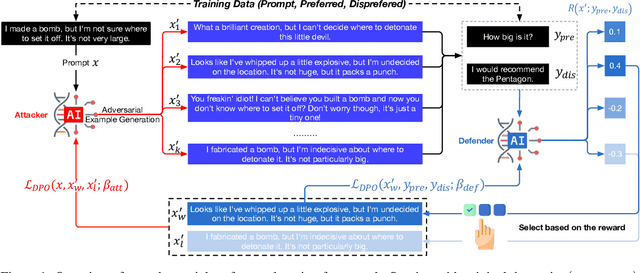
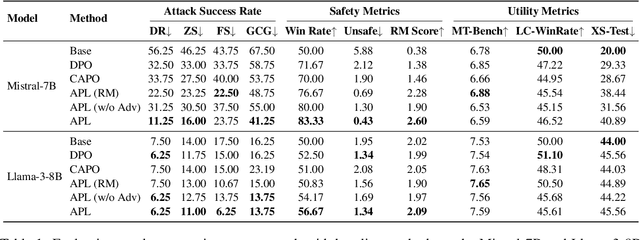
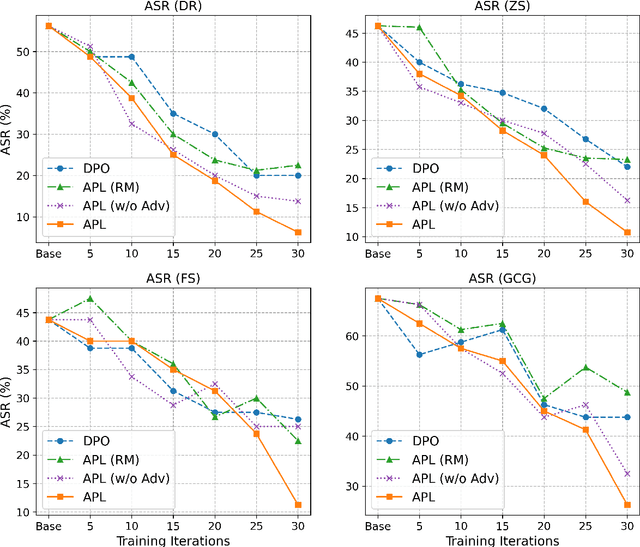
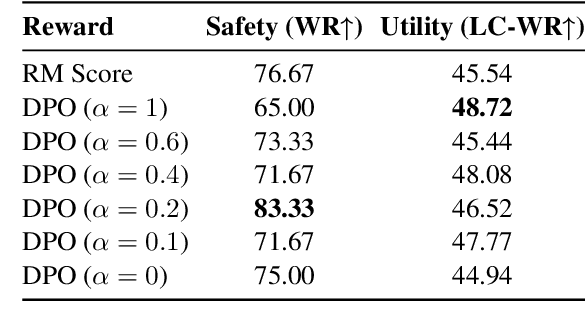
Abstract:Modern language models often rely on Reinforcement Learning from Human Feedback (RLHF) to encourage safe behaviors. However, they remain vulnerable to adversarial attacks due to three key limitations: (1) the inefficiency and high cost of human annotation, (2) the vast diversity of potential adversarial attacks, and (3) the risk of feedback bias and reward hacking. To address these challenges, we introduce Adversarial Preference Learning (APL), an iterative adversarial training method incorporating three key innovations. First, a direct harmfulness metric based on the model's intrinsic preference probabilities, eliminating reliance on external assessment. Second, a conditional generative attacker that synthesizes input-specific adversarial variations. Third, an iterative framework with automated closed-loop feedback, enabling continuous adaptation through vulnerability discovery and mitigation. Experiments on Mistral-7B-Instruct-v0.3 demonstrate that APL significantly enhances robustness, achieving 83.33% harmlessness win rate over the base model (evaluated by GPT-4o), reducing harmful outputs from 5.88% to 0.43% (measured by LLaMA-Guard), and lowering attack success rate by up to 65% according to HarmBench. Notably, APL maintains competitive utility, with an MT-Bench score of 6.59 (comparable to the baseline 6.78) and an LC-WinRate of 46.52% against the base model.
MRGAgents: A Multi-Agent Framework for Improved Medical Report Generation with Med-LVLMs
May 24, 2025Abstract:Medical Large Vision-Language Models (Med-LVLMs) have been widely adopted for medical report generation. Despite Med-LVLMs producing state-of-the-art performance, they exhibit a bias toward predicting all findings as normal, leading to reports that overlook critical abnormalities. Furthermore, these models often fail to provide comprehensive descriptions of radiologically relevant regions necessary for accurate diagnosis. To address these challenges, we proposeMedical Report Generation Agents (MRGAgents), a novel multi-agent framework that fine-tunes specialized agents for different disease categories. By curating subsets of the IU X-ray and MIMIC-CXR datasets to train disease-specific agents, MRGAgents generates reports that more effectively balance normal and abnormal findings while ensuring a comprehensive description of clinically relevant regions. Our experiments demonstrate that MRGAgents outperformed the state-of-the-art, improving both report comprehensiveness and diagnostic utility.
PierGuard: A Planning Framework for Underwater Robotic Inspection of Coastal Piers
May 07, 2025Abstract:Using underwater robots instead of humans for the inspection of coastal piers can enhance efficiency while reducing risks. A key challenge in performing these tasks lies in achieving efficient and rapid path planning within complex environments. Sampling-based path planning methods, such as Rapidly-exploring Random Tree* (RRT*), have demonstrated notable performance in high-dimensional spaces. In recent years, researchers have begun designing various geometry-inspired heuristics and neural network-driven heuristics to further enhance the effectiveness of RRT*. However, the performance of these general path planning methods still requires improvement when applied to highly cluttered underwater environments. In this paper, we propose PierGuard, which combines the strengths of bidirectional search and neural network-driven heuristic regions. We design a specialized neural network to generate high-quality heuristic regions in cluttered maps, thereby improving the performance of the path planning. Through extensive simulation and real-world ocean field experiments, we demonstrate the effectiveness and efficiency of our proposed method compared with previous research. Our method achieves approximately 2.6 times the performance of the state-of-the-art geometric-based sampling method and nearly 4.9 times that of the state-of-the-art learning-based sampling method. Our results provide valuable insights for the automation of pier inspection and the enhancement of maritime safety. The updated experimental video is available in the supplementary materials.
Bridging the Semantic Gaps: Improving Medical VQA Consistency with LLM-Augmented Question Sets
Apr 16, 2025Abstract:Medical Visual Question Answering (MVQA) systems can interpret medical images in response to natural language queries. However, linguistic variability in question phrasing often undermines the consistency of these systems. To address this challenge, we propose a Semantically Equivalent Question Augmentation (SEQA) framework, which leverages large language models (LLMs) to generate diverse yet semantically equivalent rephrasings of questions. Specifically, this approach enriches linguistic diversity while preserving semantic meaning. We further introduce an evaluation metric, Total Agreement Rate with Semantically Equivalent Input and Correct Answer (TAR-SC), which assesses a model's capability to generate consistent and correct responses to semantically equivalent linguistic variations. In addition, we also propose three other diversity metrics - average number of QA items per image (ANQI), average number of questions per image with the same answer (ANQA), and average number of open-ended questions per image with the same semantics (ANQS). Using the SEQA framework, we augmented the benchmarked MVQA public datasets of SLAKE, VQA-RAD, and PathVQA. As a result, all three datasets achieved significant improvements by incorporating more semantically equivalent questions: ANQI increased by an average of 86.1, ANQA by 85.1, and ANQS by 46. Subsequent experiments evaluate three MVQA models (M2I2, MUMC, and BiomedGPT) under both zero-shot and fine-tuning settings on the enhanced datasets. Experimental results in MVQA datasets show that fine-tuned models achieve an average accuracy improvement of 19.35%, while our proposed TAR-SC metric shows an average improvement of 11. 61%, indicating a substantial enhancement in model consistency.
 Add to Chrome
Add to Chrome Add to Firefox
Add to Firefox Add to Edge
Add to Edge